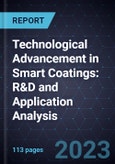Technology Strategies focus on Improved Performance, Cost Savings, and Environmental Benefits
Smart coatings play a significant role in a wide range of industrial and application segments because of their unique capabilities, such as improving surface properties, adding different functionalities, increasing efficiency, protecting against environmental elements, and enhancing the aesthetics of the structure.
The “Advances in Smart Coatings: R&D and Application Analysis” focuses on identifying and analyzing research initiatives taken by different companies and universities for the development of novel materials and processes across different industrial segments under each category of smart coatings. The developments are categorized into four major approaches: self-healing coatings, repellent coatings, conductive coatings, and sensor-based coatings. The analytics identifies drivers and restraints that lead to the adoption of smart coatings. The toxicity of conventional coating solutions, the presence of heavy metals and volatile organic compounds drive R&D and uptake of smart coatings. EPA and ECHO regulations and other strict initiatives in North America and Europe are promoting sustainability by reducing harmful emissions and encouraging resource efficiency. However, integrating smart coatings into existing manufacturing processes, capital required to develop novel materials and follow production protocols, and recycling are major challenges.
Overall, the market for smart coatings is poised for expansion and presents several growth opportunities that are driven by the convergence of different advancements in technology, increasing industry demand for advanced functionalities, and focus on sustainability and environmental protection.








